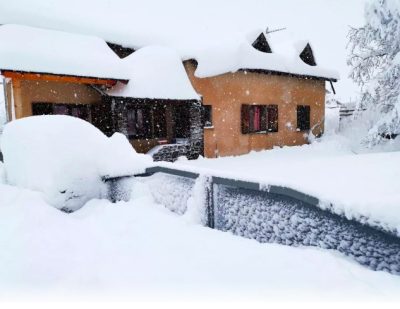sustainability in “Magpie and persimmon”

Persimmon gardens along rural roads in northern South Korea are a unique sight in the golden autumn.
Regular visitors to the area will find a unique sight: at the top of the persimmon trees there are always a few large red persimmons left unpicked. Even after the picking season is over, the persimmons remain on the trees, some even until the following spring. In the end, most of the remaining persimmons gradually decay and fall to the ground. These persimmons left to cause a lot of tourists curious: “These persimmons left so, although good-looking, but this is not a bit of waste?” In order to find out what was going on, some tourists asked the local farmers: “These persimmons are big and red. It’s a pity not to pick them. If you pick them, you can certainly sell them for a lot of money.” But the local farmers said: “No matter how good the persimmons are, they should not be picked. They are for the magpies to eat in winter.” Some tourists do not believe, and asked a lot of farmers, the answer is still the same.
When everyone was confused, the old man in the village told us a story: Persimmon gardens in South Korea are rich in sweet fruits, and each autumn brings sweet rewards to farmers who have worked hard all year. It is also the habitat of magpies, who nest in the fruit trees every winter. Humans and magpies live a peaceful life.

One particularly cold winter, snow almost covered the whole village, everywhere was white and heavy snow. This led to the magpies not being able to find food, coupled with the harsh cold, and eventually large numbers of magpies died of hunger and cold that winter.
Farmers did not initially care about the large number of dead magpies because they were not thought to affect the following year’s harvest.
But the next spring, the persimmon trees blossomed, and as farmers looked forward to a good harvest, an unknown bug suddenly took hold. This bug eats everything, tree trunks, leaves, flowers, immature fruit, and gnaws holes in its path. People tried various methods but failed to control the disaster effectively. In the autumn, the trees so tortured that unable to produce fruit, and the farmers have almost no harvest.

Then farmers remembered that the bug appeared every year, but never a disaster. The reason is that the magpies that live in the trees catch them for food to feed their young. While their daily work is unremarkable, the magpies catch bugs every day virtually protect the farmers’ fruits. Because so many magpies didn’t make it through the cold winter, the insects, which had no natural predators, thrived.

Every autumn since then, when the persimmons are harvested, farmers here leave some of the topmost of them on the trees as food for the magpies during the winter. The persimmon left on the trees attracted a large number of magpies to winter, the next spring, as if to repay the farmers for leaving food, magpies will dutifully and efficiently exterminate the insects on the fruit trees. There is always a bumper harvest of persimmons in autumn.

The farmers in the story apply the concept of sustainable development into practice invisibly, which not only plays a positive role in the protection of the ecological environment, but also reap long-term benefits in the future.
At present, sustainable development is an issue that the whole world should ponder. The world’s resources are rapidly shrinking. According to statistics, with the current proved quantity, the world’s oil resources can still be used for about 55 years; Coal can only be mined for about 200 years on Earth. If all these resources are used up, what will future generations live on? Where does the future of mankind lie?
In real life human tend to overlook the importance of sustainable development: the COP26 was held in Glasgow in 2021, the south Pacific island nation of Tuvalu foreign minister Simon Kofe visual speech in the knee of the sea water, said “My country is being flooded by the rising coastline”, to show the country is facing to the global crisis of climate change and rising sea levels.

Dressed in a suit and standing at a podium in the middle of the sea with his trousers rolled up, Kofe said the show was meant to show that Tuvalu is at the front of the line in terms of climate change and rising sea levels: “You can see the impact of climate change and rising sea levels on Tuvalu from where I am.”

In 2009, the Copenhagen climate conference was billed by the media as the last chance to save the planet. At the meeting, the president of the Pacific island nation wept that if the problem is not solved and global temperatures continue to rise at the current rate, in a few years his country will be swamped by rising coastlines caused by melting glaciers. However, the outcome of the meeting was disappointing. None of the great powers would give up their immediate interests, and none would take a step back. Under the banner of environmental protection, it failed to unite the heads of state as expected, and it was still closely related to interests.
If they can make concessions for the future and think in a sustainable way, like the farmers in the magpie story, the benefits of environmental governance will be good for the country in the long run. Although some of the smaller immediate benefits are sacrificed, in the long run this sustainable development will bring them greater benefits in the future.
Minister Kofe’s video statement: COP26
References
Abc.net.au. 2022. Tuvalu minister gives COP26 speech standing knee-deep in the sea. [online] Available at: [Accessed 13 October 2022].
BBC News. 2022. Paris climate summit: Don’t mention Copenhagen. [online] Available at: [Accessed 13 October 2022].
